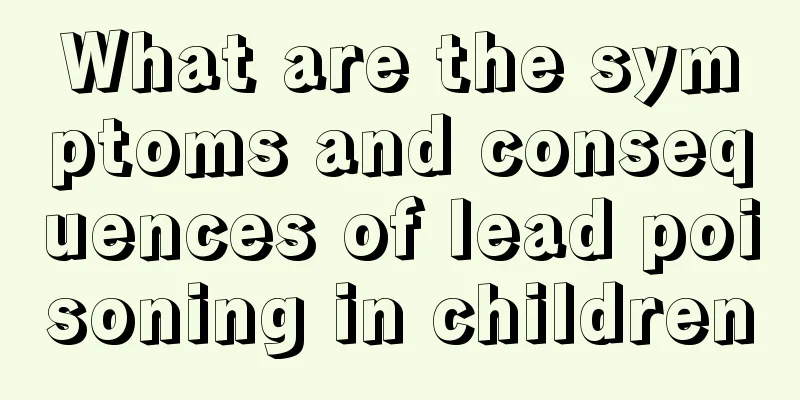What are the symptoms and consequences of lead poisoning in children

|
Lead poisoning is relatively common among children and is very harmful to their growth and development. It can cause slow growth and development, hyperactivity, temper tantrums, irritability, slow reactions, etc. These are all common symptoms of lead poisoning. If it is severe lead poisoning, it can also cause hepatosplenomegaly and circulatory failure. The harm to children's future, growth and development is very great. Symptoms of lead poisoning in children Children with acute lead poisoning have a metallic taste in the mouth, drooling, nausea, and vomiting. The vomitus is often white milk-like (lead forms white lead chloride in the stomach). They also have abdominal pain, sweating, irritability, and refusal to eat. When acute lead poisoning encephalopathy occurs, persistent vomiting (which may be projectile) occurs suddenly, accompanied by increased breathing and pulse, ataxia, strabismus, convulsions, coma, etc.; at this time, blood pressure may increase and optic disc edema may occur. The baby's anterior fontanelle is full, and even the skull sutures are widened and the head circumference increases. Children with severe lead poisoning often have paroxysmal abdominal colic, and may develop hepatomegaly, jaundice, oliguria or anuria, circulatory failure, etc. A few people have gastrointestinal bleeding and paralytic intestinal obstruction. Most of the sick children have no fever or only a slight fever. Patients with a longer illness period also have anemia, a gray (leady) face, and are accompanied by palpitations, shortness of breath, fatigue, etc. Teeth and nails may be stained black due to lead deposits, and black "lead lines" on the gums are rarely seen in young children. Numbness of the limbs and wrist and ankle drop signs at the distal ends of the limbs are relatively rare in infancy; numbness of the fingers and toes is a common symptom in older children. Sometimes limb paralysis may be seen. If intercostal muscle paralysis occurs, breathing difficulties or even respiratory failure may occur. Chronic lead poisoning is more common in children over 2 to 3 years old, and it usually takes about 3 to 6 months from ingestion to the onset of symptoms. The main manifestations are severe central nervous system lesions such as epileptic seizures, excessive movement, aggressive behavior, delayed or even loss of language function, etc., but there are no signs of acute increased intracranial pressure. Such chronic encephalopathy may be a sequela of acute encephalopathy or may be associated with frequent excessive lead intake. In addition, it should be noted that when gastrointestinal symptoms appear in the early stage of lead poisoning, it should be differentiated from acute gastroenteritis, viral hepatitis, etc.; when there is abdominal colic, it must be differentiated from acute abdomen; when signs of encephalopathy occur, it should be differentiated from encephalitis, tuberculous meningitis, brain tumors and tetany; when there are symptoms and signs of peripheral neuritis, it must be differentiated from poliomyelitis and diphtheria nerve paralysis. What is lead poisoning? Before confirming that your baby has lead poisoning, you must first understand what lead poisoning is. Lead and its compounds are toxic to all tissues of the human body. Poisoning can occur through inhalation of its vapor or dust through the respiratory tract, which is then rapidly carried into the blood by phagocytes in the respiratory tract; or it can be absorbed through the digestive tract and enter the blood circulation, causing poisoning. The poisoned people generally have a history of contact with lead and lead compounds. Oral intake of 2-3 grams can cause poisoning, and 50 grams can be fatal. Clinical lead poisoning is rare. Generally speaking, when the blood lead concentration exceeds 100 micrograms/liter, it will cause harm to health, but the child may not have any clinical symptoms at this time. Therefore, it is best to test your child's blood lead level once when he or she is 1 year old and again when he or she is 2 years old. Lead poisoning in children may manifest as hyperactivity, irritability, and temper. They may often have friction with other children and bite or hit others when they are angry. Some may also show slow reaction and even convulsions. If not treated in time, it may cause a series of complications. Poor appetite, abdominal pain, anemia, hyperactivity, and inattention have all been described as being related to lead poisoning, but these symptoms are not specific to lead poisoning. |
<<: What are the symptoms of excessive formaldehyde inhalation
>>: What are the symptoms of having a baby girl
Recommend
Bladder cancer disease health knowledge
Bladder cancer can also bring certain pain to pat...
Metastasis pathways and symptoms of esophageal cancer
The early lesions of esophageal cancer are confin...
What disease is it that makes hair smell?
Each of us has smooth hair. Under normal circumst...
Can bird flu symptoms be cured?
Human infection with avian influenza has become m...
Genetic testing for hereditary endometrial cancer
Endometrial cancer (EC), also known as uterine bo...
Will frequent hair blow-drying cause hair loss?
Everyone has this confusion: every time we finish...
What are the sequelae of mild cerebral infarction
Cerebral infarction mainly refers to the problem ...
Does dried jackfruit cause internal heat?
Dried jackfruit is very common, and there are man...
Survival rate of breast cancer in middle and late stages
Survival rate of breast cancer in advanced stage ...
What tests should be done if prostate cancer is suspected? Five tests should be done if prostate cancer is suspected
In recent years, the incidence of cancer has been...
Are tomatoes a cold or warm food?
Tomatoes are a favorite food of many people. Toma...
It turns out that Kapok soup has these magical effects
Now is the season when kapok flowers bloom. This ...
Does watermelon cause internal heat? What should we pay attention to when eating watermelon
Watermelon is a must-have summer delicacy for coo...
What is interventional treatment for liver cancer? Detailed introduction to common knowledge of interventional treatment for liver cancer
Interventional treatment of liver cancer is a min...
What are the symptoms of colorectal cancer
The symptoms of colorectal cancer vary depending ...









